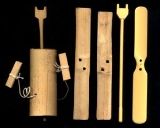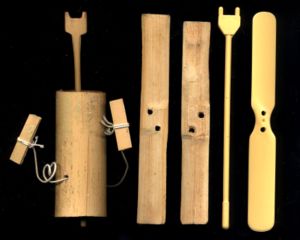
Bamboo-copter
Encyclopedia


Chinese language
The Chinese language is a language or language family consisting of varieties which are mutually intelligible to varying degrees. Originally the indigenous languages spoken by the Han Chinese in China, it forms one of the branches of Sino-Tibetan family of languages...
zhuqingting , Japanese
Japanese language
is a language spoken by over 130 million people in Japan and in Japanese emigrant communities. It is a member of the Japonic language family, which has a number of proposed relationships with other languages, none of which has gained wide acceptance among historical linguists .Japanese is an...
taketombo ) is a toy
Toy
A toy is any object that can be used for play. Toys are associated commonly with children and pets. Playing with toys is often thought to be an enjoyable means of training the young for life in human society. Different materials are used to make toys enjoyable and cuddly to both young and old...
propeller
Propeller (aircraft)
Aircraft propellers or airscrews convert rotary motion from piston engines or turboprops to provide propulsive force. They may be fixed or variable pitch. Early aircraft propellers were carved by hand from solid or laminated wood with later propellers being constructed from metal...
that flies up when its shaft is rapidly spun. This helicopter
Helicopter
A helicopter is a type of rotorcraft in which lift and thrust are supplied by one or more engine-driven rotors. This allows the helicopter to take off and land vertically, to hover, and to fly forwards, backwards, and laterally...
-like top
Top
A top is a toy that can be spun on an axis, balancing on a point. This motion is produced in the most simple forms of top by twirling the stem using the fingers. More sophisticated tops are spun by by holding the axis firmly while pulling a string or twisting a stick or pushing an auger as shown...
originated in Warring States Period
Warring States Period
The Warring States Period , also known as the Era of Warring States, or the Warring Kingdoms period, covers the Iron Age period from about 475 BC to the reunification of China under the Qin Dynasty in 221 BC...
China around 400 BCE, and was the object of early experiments by George Cayley
George Cayley
Sir George Cayley, 6th Baronet was a prolific English engineer and one of the most important people in the history of aeronautics. Many consider him the first true scientific aerial investigator and the first person to understand the underlying principles and forces of flight...
, the inventor of modern aeronautics
Aeronautics
Aeronautics is the science involved with the study, design, and manufacturing of airflight-capable machines, or the techniques of operating aircraft and rocketry within the atmosphere...
.
In China, the earliest known flying toys consisted of feathers at the end of a stick, which was rapidly spun between the hands and released into flight. "While the Chinese top was no more than a toy, it is perhaps the first tangible device of what we may understand as a helicopter."
The Daoist scholar Ge Hong
Ge Hong
Ge Hong , courtesy name Zhichuan , was a minor southern official during the Jìn Dynasty of China, best known for his interest in Daoism, alchemy, and techniques of longevity...
's (ca. 317) book Baopuzi
Baopuzi
The Baopuzi , written by the Jin Dynasty scholar Ge Hong 葛洪 , is divided into esoteric Neipian 內篇 "Inner Chapters" and exoteric Waipian 外篇 "Outer Chapters". The Daoist Inner Chapters discuss topics such as techniques for xian 仙 "immortality; transcendence", Chinese alchemy, elixirs, and demonology...
(抱樸子 "Master Who Embraces Simplicity") mentioned a flying vehicle in what Joseph Needham
Joseph Needham
Noel Joseph Terence Montgomery Needham, CH, FRS, FBA , also known as Li Yuese , was a British scientist, historian and sinologist known for his scientific research and writing on the history of Chinese science. He was elected a fellow of the Royal Society in 1941, and as a fellow of the British...
calls "truly an astonishing passage".
Some have made flying cars [feiche 飛車] with wood from the inner part of the jujube tree, using ox-leather (straps) fastened to returning blades so as to set the machine in motion [huan jian yi yin chiji 環劍以引其機]. Others have had the idea of making five snakes, six dragons and three oxen, to meet the "hard wind" [gangfeng 罡風] and ride on it, not stopping until they have risen to a height of forty liLi (unit)The li is a traditional Chinese unit of distance, which has varied considerably over time but now has a standardized length of 500 meters or half a kilometer...
. That region is called [Taiqing 太清] (the purest of empty space). There the [qiQiIn traditional Chinese culture, qì is an active principle forming part of any living thing. Qi is frequently translated as life energy, lifeforce, or energy flow. Qi is the central underlying principle in traditional Chinese medicine and martial arts...
] is extremely hard, so much so that it can overcome (the strength of) human beings. As the Teacher says: "The kite (bird) flies higher and higher spirally, and then only needs to stretch its two wings, beating the air no more, in order to go forward by itself. This is because it starts gliding (lit. riding) on the 'hard wind' [gangqi 罡炁]. Take dragons, for example; when they first rise they go up using the clouds as steps, and after they have attained a height of forty li then they rush forward effortlessly (lit. automatically) (gliding)." This account comes from the adepts [xianren 仙人], and is handed down to ordinary people, but they are not likely to understand it.
Needham concludes Ge Hong was describing helicopter tops because "'returning (or revolving) blades' can hardly mean anything else, especially in close association with a belt or strap"; and suggests that "snakes", "dragons", and "oxen" refer to shapes of man-lifting kite
Man-lifting kite
A man-lifting kite is a kite designed to lift a person from the ground. Historically, man-lifting kites have been used chiefly for reconnaissance and entertainment. Interest in their development declined with the advent of powered flight at the beginning of the 20th century.-Early history:The first...
s. Other scholars interpret this Baopuzi passage mythologically instead of literally, based up its context mentioning fantastic flights through chengqiao (乘蹻 "riding on tiptoe/stilts") and xian
Xian (Taoism)
Xian is a Chinese word for an enlightened person, translatable in English as:*"spiritually immortal; transcendent; super-human; celestial being"...
(仙 "immortal; adept") techniques. For instance, "If you can ride the arches of your feet, you will be able to wander anywhere in the world without hindrance from mountains or rivers … Whoever takes the correct amulet and gives serious thought to the process may travel a thousand miles by concentrating his thoughts for one double hour." Compare this translation.
Some build a flying vehicle from the pith of the jujube tree and have it drawn by a sword with a thong of buffalo hide at the end of its grip. Others let their thoughts dwell on the preparation of a joint rectangle from five serpents, six dragons, and three buffaloes, and mount in this for forty miles to the region known as Paradise.
This Chinese helicopter toy was introduced into Europe and "made its earliest appearances in Renaissance European paintings and in the drawings of Leonardo da Vinci." The toy helicopter appears in a ca. 1460 French picture of the Madonna and Child at the Musée de l'Ancien Évêché in Le Mans, and in a 16th-century stained glass panel at the Victoria and Albert Museum
Victoria and Albert Museum
The Victoria and Albert Museum , set in the Brompton district of The Royal Borough of Kensington and Chelsea, London, England, is the world's largest museum of decorative arts and design, housing a permanent collection of over 4.5 million objects...
in London. A ca. 1560 picture by Pieter Breughel the Elder at the Kunsthistorisches Museum
Kunsthistorisches Museum
The Kunsthistorisches Museum is an art museum in Vienna, Austria. Housed in its festive palatial building on Ringstraße, it is crowned with an octagonal dome...
in Vienna depicts a helicopter top with three airscrews.
"The helicopter top in China led to nothing but amusement and pleasure, but fourteen hundred years later it was to be one of the key elements in the birth of modern aeronautics in the West." Early Western scientists developed flying machines based upon the original Chinese model. The Russian polymath Mikhail Lomonosov
Mikhail Lomonosov
Mikhail Vasilyevich Lomonosov was a Russian polymath, scientist and writer, who made important contributions to literature, education, and science. Among his discoveries was the atmosphere of Venus. His spheres of science were natural science, chemistry, physics, mineralogy, history, art,...
developed a spring-driven coaxial rotor in 1743, and the French naturalist Christian de Launoy created a bow drill
Bow drill
The bow drill is an ancient tool. While it was usually used to make fire, it was also used for primitive woodworking and dentistry. It consists of a bearing block or handhold, a spindle or drill, a hearth or fireboard, and a simple bow...
device with contra-rotating feather propeller
Propeller (aircraft)
Aircraft propellers or airscrews convert rotary motion from piston engines or turboprops to provide propulsive force. They may be fixed or variable pitch. Early aircraft propellers were carved by hand from solid or laminated wood with later propellers being constructed from metal...
s.
In 1792, George Cayley began experimenting with helicopter tops, which he later called "rotary wafts" or "elevating fliers". His landmark (1809) article "On Aerial Navigation" pictured and described a flying model with two propellers (constructed from corks and feathers) powered by a whalebone bow drill. "In 1835 Cayley remarked that while the original toy would rise no more than about 6 or 7.5 metres, his improved models would 'mount upward of 90 ft (27 metres) into the air'. This then was the direct ancestor of the helicopter rotor and the aircraft propeller."
Discussing the history of Chinese inventiveness, Joseph Needham
Joseph Needham
Noel Joseph Terence Montgomery Needham, CH, FRS, FBA , also known as Li Yuese , was a British scientist, historian and sinologist known for his scientific research and writing on the history of Chinese science. He was elected a fellow of the Royal Society in 1941, and as a fellow of the British...
wrote, "Some inventions seem to have arisen merely from a whimsical curiosity, such as the 'hot air balloons' made from eggshells which did not lead to any aeronautical use or aerodynamic discoveries, or the zoetrope
Zoetrope
A zoetrope is a device that produces an illusion of action from a rapid succession of static pictures. The term zoetrope is from the Greek words "ζωή – zoe", "life" and τρόπος – tropos, "turn". It may be taken to mean "wheel of life"....
which did not lead onto the kinematograph, or the helicopter top which did not lead to the helicopter."
External links
- Uncle Igor & the Chinese Top, Time Magazine 16 Nov 1953
- The Helicopter: A Hundred Years of Hovering, Wired Magazine 12 Nov 2007
- What is a Taketonbo?, Taketonbo.org
- Bamboo Dragonflies, Cultural China

